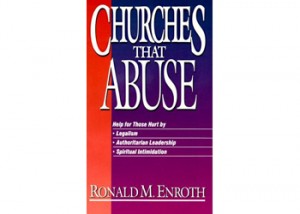 Many Christians have experienced, or are currently in an abusive Church. Dr. Ronald M. Enroth wrote several books on the issue of Church Abuse.
Many Christians have experienced, or are currently in an abusive Church. Dr. Ronald M. Enroth wrote several books on the issue of Church Abuse.
Apologetics index has the complete text of two important books on the subject.
The following is from that website. See the link below to read the entire book.
While Churches That Abuse has now been out of print for a number of years, it continues to be of great help to — as the cover states — those hurt by:
- Legalism
- Authoritarian Leadership
- Manipulation
- Excessive Discipline, and
- Spiritual Intimidation
Ronald M. Enroth is a leading scholar and national resource on cults and cultism whose special perspectives are heartily welcomed by both the secular and the religious society. He is professor of sociology at Westmont College and the author of many books on cults and the new religions including The Lure of the Cults and New Religions and Evangelizing the Cults.
The following description comes from the book’s front flap:
When does a church cross the line between conventional church status and fringe status? What is the nature of the process by which any given group devolves into a fringe church or movement? What are some of the signs or indicators that a given group is becoming abusive of its members and is headed for the margins? When should a member consider bailing out?
Churches That Abuse answers these and other important questions about abusive churches. This important new book warns and informs readers about the “fringe” churches and groups that operate in this country—organizations and churches that are not necessarily characterized by doctrinal deviation but have particular traits that make them behavioral and sociological outsiders. It also helps readers identify and beware of abusive tendencies in more “normal” Christian churches.
Ronald Enroth identifies what is meant by “abusive churches.” Then, he describes abusive churches, using the ten identifying traits of control-oriented leadership, spiritual elitism, manipulation of members, perceived persecution, lifestyle rigidity, emphasis on experience, suppression of dissent, harsh discipline of members, denunciation of other churches, and the painful exit process. Finally he shows readers how to discern fringe churches and offers several “red flags” that can be discerned when convention churches drift toward the fringe.
Churches That Abuse tells who the abusers are, how their techniques operate, and what the consequences are for marriages, small children, and teenagers. Where most books stop after reporting problem areas, this one continues and offers suggestions for those helping victims of abuse. And it can be read beneficially by those who are involved in abusive churches and have no one to turn to.
– Source: Front flap, Churches That Abuse, by Ronald M. Enroth
From Amazon.com
One of the first books to talk about religious abuse, May 23, 1999
By A Customer
This review is from: Churches That Abuse (Paperback)
There is a myth out there that unless the church is part of some far-out cult it is 100% safe.
The truth is there are churches that abuse, even in mainline and evangelical protestant denominations.
The book perpetuates the myth some as the examples are given from more “cult-ish” groups.
No, not every church abuses. Sometimes otherwise healthy, vibrant churches can have unhealthy, abusive pockets or sub-groups in them due to the negative influence of one or two leaders. And emotionally abusive parents can visit spiritual abuse on their children even in an overall healthy church.
The outline of the chapters in the book gives an excellent guide for evaluating one’s church experience and if it is abusive:
Ten characteristics of churches that abuse:
* Abusive churches use fear, guilt and threats:
1. Control-oriented leadership
2. Manipulation of members
* Abusive churches see themselves as special:
3. Spiritual elitism (e.g., dogmatism)
4. Perceived persecution
* Abusive churches foster rigidity:
5. Lifestyle rigidity (e.g., legalism, performance oriented)
6. Emphasis on experience (e.g., experience of leaders is key source of truth)
* Abusive churches discourage questions:
7. Suppression of dissent (e.g., dogmatism–only our view is right; “trust and obey”)
8. Harsh discipline (e.g., legalism, shunning, control of dating & family relationships, etc.)
* Abusive churches make leaving painful:
9. Denunciation of other churches (e.g. salvation is only through us, our brand of faith)
10. A painful exit process (shunning, humiliation, starting over in relationships and/or financially)
Table of Contents
Churches That Abuse — Online Book
Churches That Abuse — Notice & Disclaimer
Churches That Abuse — Contents / Audio Version
Churches That Abuse — Publishers Information
Churches That Abuse: Preface & Acknowledgements
Abusive Churches: Chapter 1 — A View From Within
Chapter 2: Fringe and Fanaticism – Abusive Churches Can Go Over The Edge
Chapter 3: Abusive Churches Are Not New
Chapter 4: Abusive Churches Misuse Spiritual Authority
Chapter 5: Abusive Churches Use Fear, Guilt, and Threats
Chapter 6: Abusive Churches See Themselves As Special
Chapter 7: Abusive Churches Foster Rigidity
Chapter 8: Abusive Churches Discourage Questions
Chapter 9: Abusive churches make leaving painful
Chapter 10: Abusive Churches Present A Warning
Chapter 11: Abusive Churches Will Always Exist
See http://www.apologeticsindex.org/e21.html
The publishers of Apologetics Index have received permission from Dr. Ronald M. Enroth to post online the full text of his book, Churches That Abuse.
Also online, the full text of the sequel, Recovering From Churches That Abuse.

